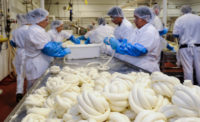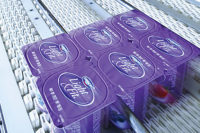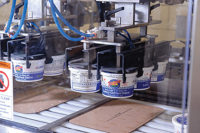Dairy Products Quality Manager Jill Allen earned an American Cheese Graders license from the state of Wisconsin by passing a rigorous examination. Allen is the gatekeeper of all of Tillamook’s dairy products. Besides testing the cheese and ice cream manufactured in Tillamook, she tests the cheese that is produced in Boardman, Ore., and the yogurt, sour cream and butter processed by co-packers and license partners.
In a room in the warehouse, Allen and six co-workers evaluate samples from the first and last blocks of cheese from each vat from each production run. Before they start work, each member of the sensory team is required to have eaten enough for breakfast to be satisfied. (“We don’t want to be full,” Allen said, but neither does she want her team to show up hungry.)
In one day they will sample from 120 to 500 pieces of product. The evaluation involves all the senses. They inspect the color of the cheese for mottling. By smelling the cheese, they can detect fatty acids. Allen bends a plug of cheese to see how and when it breaks. She listens to it, too. She feels the sample for the texture. The cheese should not be sticky. Then the team tastes the sample (although they don’t ingest it), and listens again as the cheese is chewed.
Allen is also the cheese grader. All of Tillamook’s cheeses are naturally aged. She determines which lots become medium, sharp and extra sharp. Her sensory evaluation plays a role in the determination, but so do sales forecasts. Tillamook needs to balance the demands for medium and aged Cheddars. In fact, managing the cheese aging program is one of the most significant challenges Tillamook has.
“Because we are naturally aging our product, the levels of inventory required as well as the time between manufacture and sale can be a challenge given how volatile dairy markets are,” said Jay Allison, vice president of sales
and marketing.
It is rare that Allen rejects an entire production run, but it has happened. If the color is not consistent, Allen might assign the cheese to be shredded because color consistency is not as important as it is for blocks. When cheese does not meet standards, Allen and the production team try to figure out what went wrong. It could be that a salt lance broke without the operator noticing, Allen said, or there was some other problem on the line or with ingredients. In any event, the aim is to correct the problem.








